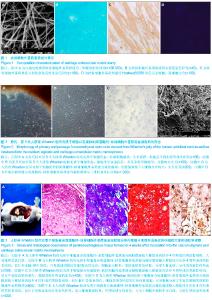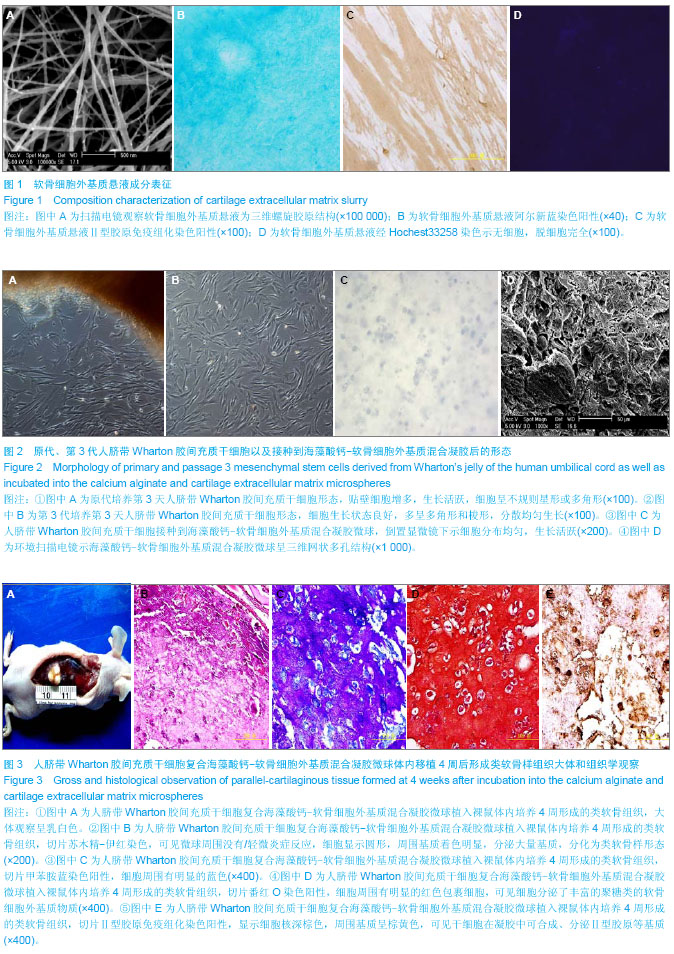| [1] Nehrer S, Spector M, Minas T. Histologic analysis of tissue after failed cartilage repair procedures. Clin Orthop Relat Res. 1999;(365):149-162.[2] Brittberg M, Lindahl A, Nilsson A,et al. Treatment of deep cartilage defects in the knee with autologous chondrocyte transplantation. N Engl J Med.1994;331(14):889-895.[3] Elder SH, Cooley AJ Jr, Borazjani A,et al. Production of hyaline-like cartilage by bone marrow mesenchymal stem cells in a self-assembly model.Tissue Eng Part A. 2009; 15(10):3025-3036. [4] 中华人民共和国科学技术部.关于善待实验动物的指导性意见. 2006-09-30.[5] Zheng XF,Lu SB,Zhang WG,et al. Mesenchymal Stem Cells on Decellularized Cartiage Matrix for Cartilage Tissue Engineering. Biotechnoligy and Bioprocess Engineering. 2011;16:593-602.[6] 王玉,彭江,张莉,等.软骨细胞外基质/壳聚糖复合多孔支架和骨髓间充质干细胞构建组织工程软骨[J].中国矫形外科杂志, 2010,18(20):1715-1718.[7] Brittberg M, Lindahl A, Nilsson A,et al.Treatment of deep cartilage defects in the knee with autologous chondrocyte transplantation. N Engl J Med. 1994;331(14):889-895.[8] Elder SH, Cooley AJ Jr, Borazjani A,et al. Production of hyaline-like cartilage by bone marrow mesenchymal stem cells in a self-assembly model.Tissue Eng Part A. 2009; 15(10):3025-3036. [9] Podskubka A, Povýsil C, Kubes R,et al.Treatment of deep cartilage defects of the knee with autologous chondrocyte transplantation on a hyaluronic Acid ester scaffolds (Hyalograft C).Acta Chir Orthop Traumatol Cech.2006;73(4):251-263.[10] Grande DA, Pitman MI, Peterson L,et al.The repair of experimentally produced defects in rabbit articular cartilage by autologous chondrocyte transplantation. J Orthop Res. 1989;7(2):208-218. [11] 李红喜,张睿,李华哲,等.软骨细胞联合BMP/bFGF移植对关节软骨损伤的修复作用[J].现代生物医学进展,2013,13(22): 4237-4241.[12] 陈康,王大平.组织工程软骨修复关节软骨损伤研究新进展[J].中国矫形外科杂志,2012,20(8):721-723.[13] 朱现玮,徐卫袁,张兴祥,等.多孔型丝素蛋白/羟基磷灰石复合骨髓间充质干细胞修复兔半月板无血运区软骨损伤[J].中国组织工程研究,2012,16(29):5375-5378.[14] 刘泽汉,王立春,张宏颖,等.动物脂肪干细胞联合双重转化生长因子释放支架修复关节软骨损伤的实验研究[J].中国骨与关节损伤杂志,2012,27(12):1098-1101.[15] Koch RJ, Gorti GK.Tissue engineering with chondrocytes. Facial Plast Surg. 2002;18(1):59-68.[16] Liu C, Xia Z, Czernuscka JT.Design and development of three-dimensional scaffolds for tissue engineering. Chemical Engineering Research and Design. 2007;85(7):1051-1064.[17] 侯克东,卢世璧,张莉,等.人脐带Wharton胶中间充质干细胞的分离﹑培养与鉴定[J].解放军医学杂志,2008,33(4): 375-378. [18] Penolazzi L, Vecchiatini R, Bignardi S,et al. Influence of obstetric factors on osteogenic potential of umbilical cord-derived mesenchymal stem cells. Reprod Biol Endocrinol. 2009;7:106.[19] Pereira WC, Khushnooma I, Madkaikar M,et al. Reproducible methodology for the isolation of mesenchymal stem cells from human umbilical cord and its potential for cardiomyocyte generation. J Tissue Eng Regen Med. 2008;2(7):394-399. [20] 侯克东,袁玫,张莉,等.人脐带Wharton胶中间充质干细胞体外无支架组织工程软骨的构建[J].中国组织工程研究与临床康复, 2010,14(37):6841-6846.[21] Mo XT, Guo SC, Xie HQ,et al.Variations in the ratios of co-cultured mesenchymal stem cells and chondrocytes regulate the expression of cartilaginous and osseous phenotype in alginate constructs. Bone. 2009;45(1):42-51.[22] Ma HL, Hung SC, Lin SY,et al. Chondrogenesis of human mesenchymal stem cells encapsulated in alginate beads. J Biomed Mater Res A. 2003;64(2):273-281.[23] 扶晓明. BMSCs-庆大霉素-藻酸钙三维缓释微球修复兔膝关节软骨缺损的实验研究[J].上海:第二军医大学,2012.[24] 常嘉,马绪臣,魏明洁,等.兔髁状突软骨细胞藻酸盐凝胶三维培养体系的建立[J].北京大学学报:医学版,2002,34(2):103-107.[25] Lee JY, Hall R, Pelinkovic D,et al. New use of a three-dimensional pellet culture system for human intervertebral disc cells: initial characterization and potential use for tissue engineering. Spine (Phila Pa 1976). 2001; 26(21): 2316-2322.[26] Frampton JP, Hynd MR, Shuler ML,et al. Fabrication and optimization of alginate hydrogel constructs for use in 3D neural cell culture. Biomed Mater. 2011;6(1):015002. [27] Guo JF, Jourdian GW, MacCallum DK. Culture and growth characteristics of chondrocytes encapsulated in alginate beads. Connect Tissue Res. 1989;19(2-4):277-297.[28] Stevens MM, Qanadilo HF, Langer R,et al. A rapid-curing alginate gel system: utility in periosteum-derived cartilage tissue engineering. Biomaterials. 2004 ;25(5):887-894.[29] Ghidoni I, Chlapanidas T, Bucco M,et al. Alginate cell encapsulation: new advances in reproduction and cartilage regenerative medicine. Cytotechnology. 2008;58(1):49-56. [30] Green DW, Leveque I, Walsh D, et al. Biomineralised polysaccharide capsules for encapsulation, organization, and delivery of human cell types and growth factors. Adv Funct Mater. 2005;15(6): 917-923.[31] Barry F, Boynton RE, Liu B,et al. Chondrogenic differentiation of mesenchymal stem cells from bone marrow: differentiation-dependent gene expression of matrix components. Exp Cell Res. 2001;268(2):189-200.[32] Blunk T, Sieminski AL, Appel B,et al. Bone morphogenetic protein 9: a potent modulator of cartilage development in vitro. Growth Factors. 2003;21(2):71-77.[33] 毛艳,张西正.软骨组织工程中细胞外基质的研究[J].中国临床康复,2006,10(29):152-155.[34] Shakibaei M, Merker HJ. Beta1-integrins in the cartilage matrix. Cell Tissue Res. 1999;296(3):565-573.[35] Mauck RL, Nicoll SB, Seyhan SL,et al. Synergistic action of growth factors and dynamic loading for articular cartilage tissue engineering.Tissue Eng. 2003;9(4):597-611.[36] van Susante JL, Buma P, van Beuningen HM,et al. Responsiveness of bovine chondrocytes to growth factors in medium with different serum concentrations. J Orthop Res. 2000 ;18(1):68-77.[37] Fortier LA, Mohammed HO, Lust G,et al. Insulin-like growth factor-I enhances cell-based repair of articular cartilage.J Bone Joint Surg Br. 2002;84(2):276-288. [38] Fortier LA, Nixon AJ, Lust G. Phenotypic expression of equine articular chondrocytes grown in three-dimensional cultures supplemented with supraphysiologic concentrations of insulin-like growth factor-1. Am J Vet Res. 2002;63(2): 301-305.[39] Martin I, Vunjak-Novakovic G, Yang J,et al. Mammalian chondrocytes expanded in the presence of fibroblast growth factor 2 maintain the ability to differentiate and regenerate three-dimensional cartilaginous tissue.Exp Cell Res. 1999; 253(2):681-688.[40] Paige KT, Cima LG, Yaremchuk MJ,et al. Injectable cartilage. Plast Reconstr Surg. 1995;96(6):1390-1398.[41] 陈希哲,林云锋,乔鞠.人体脂肪基质细胞复合藻酸盐异位软骨生成的研究[J].中华口腔医学杂志,2004,39(4):316-317. |

